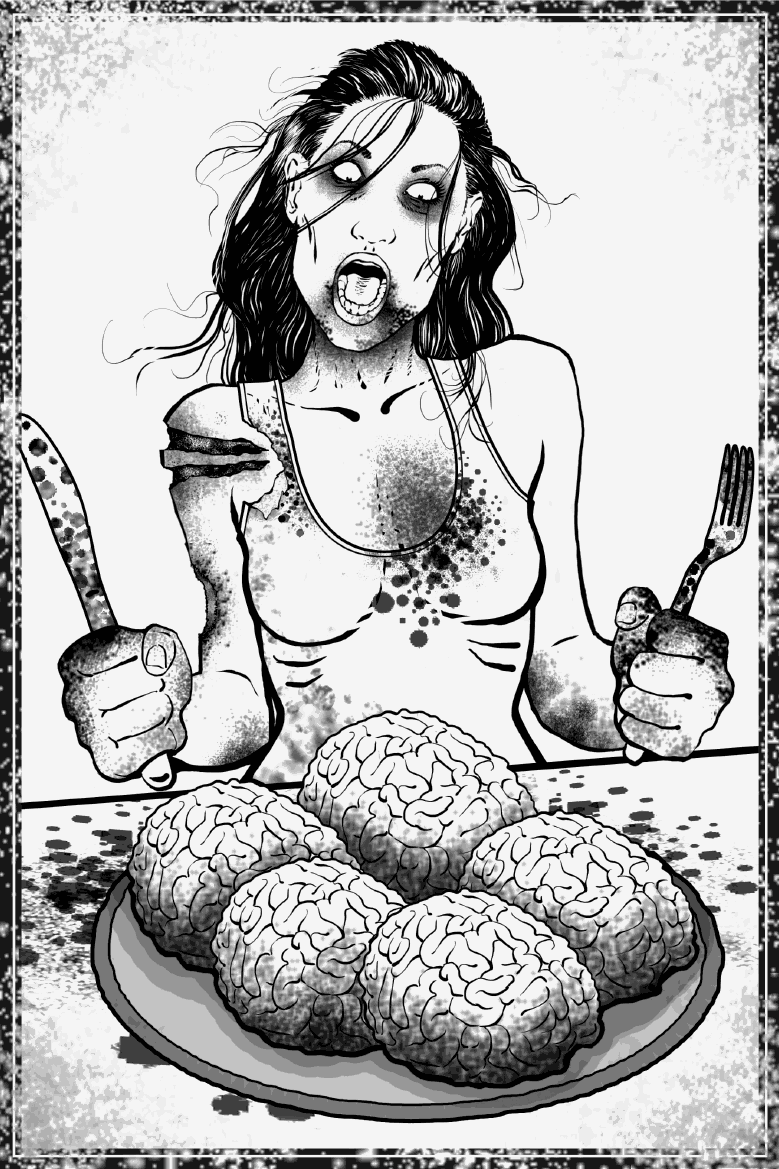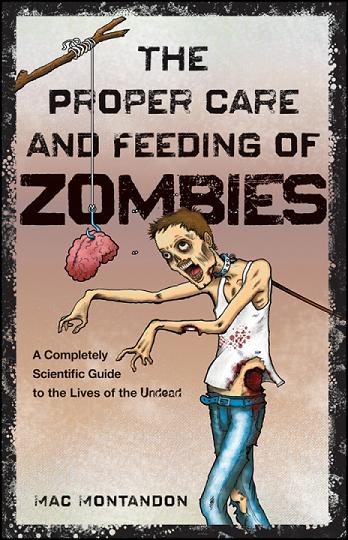We hope you enjoy this excerpt—but maybe not while eating—from The Proper Care and Feeding of Zombies, new from Wiley.
Chapter 1: Serve with a Chilled Pinot Gross
The benefits and hazards of an all-brain-and-human-flesh diet
Brains. If there is a part of the anatomy that is more famously linked to zombies than brains, I’d like to know about it. As far back as we can remember—that is to say, 1985—the undead have hungered madly for the slithery matter found between the ears. In early big-screen zombie portrayals, though, the poor suckers appeared satiated as long as they could bite off their Shylockian pound of flesh from any old part of their victims’ bodies.
In 1985’s The Return of the Living Dead (no relation to Romero’s masterpieces), however, the monsters made it very clear that what they truly coveted for supper were brains. And lots of ‘em. You may recall that it was in ROTLD that a doomed character named Tina bolted to a funeral-home attic to escape the zombific onslaught. Soon enough, however, Tina’s boyfriend, Freddy, discovered her hideout. (Okay, he was really her ex-boyfriend at that point due to certain irreconcilable differences like, for example, the fact that Freddy was intent on slurping down Tina’s neocortex and she wasn’t yet ready to take the relationship to that level.) Upon discovering the hideout, Freddy commenced crashing through the ceiling to devour her. “I love you, Tina,” zom Freddy half pleads, half demands, “and that’s why you need to let me eat your brains.”

Clearly zombies have a thing for a piping hot hypothalamus served just so with a side of corpus callosum. In fact, it’s more than a thing; it’s a gob-smacking obsession that has given rise to an enduring cultural meme with serious (atrophied, skin- flaking, rigidly unbendy) legs. In chapter 2 I will explore the effects of this resolutely undiverse diet on zombies and attempt to answer definitively the question that’s haunted us these last twenty-five years: how much brains is too much brains, nutritionally speaking?
Some nutrition experts speculate that pig is closest to human flesh, nutritionally speaking. One highly regarded nutritionist (who asked that I not use his name because he didn’t want to come off as some freak who thought about zombies all the time. Wait—what?) even told me, “Presumably, from a nutritional standpoint, there would be little difference between a human brain and a pig’s brain.” And so, given that the average human brain weighs about 3 pounds, or 1,300 to 1,400 grams, we can look at the nutritional value of 1,350 grams of pig brains to get a handle on what, exactly, zombies are eating. And what they are eating when they eat a single human brain is this: nearly 140 grams of protein, 125 grams of fat, lots of vitamin C, but barely any other vitamins and absolutely no carbs.
When that same nutritionist crunched the numbers he came up with some alarming stats for what the undead would be consuming were they to ingest a whole person. Hold on to your waistlines: a single serving of person—roughly a pound of flesh—brings with it about 4,900 grams of protein, 3,500 grams of fat, and a bit of vitamins A, B, D, and E. Also, lots of phosphorus and potassium, which would give zombies strong bones and account for why, when you bash them in the midsection with a shovel, they don’t seem to mind that much. Finally, a pound of flesh contains a rather unhealthy 17,000 milligrams of sodium — ouch!
The dietetic concerns for a zombie have to do with the actual phenomenon of a high-fat, high-protein, all-meat diet. Which brings us to the Inuit of the Canadian Arctic. They reside on a shivery slice of land at the northeasternmost limits of North America — a place called Nunavut, in Canada, which translates to “our land” in Inuktitut. The truth is that the Inuit don’t really eat only meat, but 90 percent of their diet is meat—and not just any meat. “Our meat was seal and walrus, marine mammals that live in cold water and lots of fat,” Patricia Cochran told Discover magazine in 2004, recalling her experience growing up along the Bering Sea. “We used seal oil for cooking and as a dipping sauce for food. We had moose, caribou, and reindeer. We hunted ducks, geese, and little land birds like quail, called ptarmigan. We caught crab and lots of fish—salmon, whitefish, tomcod, pike, and char . . . . We ate frozen raw whitefish, sliced thin. The elders liked stinkfish, fish buried in seal bags or cans in the tundra and left to ferment. And fermented seal flipper, they liked that too.”
In short, the Inuit like them some meat. Occasionally, in the summer, they also eat roots, greens, and berries. But mostly meat.
For the most part, it works out really well. In fact, Discover noted that it is “surprising to learn how well the Eskimo did on a high-protein, high-fat diet.” What they learned from studying the Inuit was that there are “no essential foods—only essential nutrients.” Get those into your system and you can hunt down and gnaw up humans all day long without ever growing weary.
So why have some researchers found that the cardiac-related deaths for the Inuit are about half of what they are for average Americans when roughly 50 percent of Inuit caloric intake comes by way of fat? At the risk of sounding like a three a.m. infomercial, it seems to be because of that old nutritional battle—good fats versus bad fats. And good fats rule! Because the Inuit eat only wild animals, they consume far less saturated fat than the highly processed junk most Americans are used to tossing down our gullets. And remember all those chilly, slithery, cold-water creatures our Arctic cousins enjoy? They are packed full of omega-3 fatty acids. Fatty acids may sound like something really bad for you, but in fact they are quite helpful in preventing heart disease and in strengthening the vascular system. Whale blubber, it turns out, is about 70 percent monounsaturated (or good) fat and 30 percent omega-3 fatty acids. It’s the perfect dish!
The only problem for zombies is that they generally aren’t eating whale blubber—they are eating us. So it could be argued that their health risks are considerably higher than the average Inuit’s. Because if we are what we eat—and recent obesity trends, sadly, do seem to be bearing out that this is the case—and zombies are eating us, they are consuming way too much saturated fat, bad cholesterol, and, maybe worst of all, trans fats. Hear that, zombies? So if you are worried about a zombie’s nutritional intake, there is an easy way to fix the problem: force yourself to have a healthier diet.
Of course, all of this could be for naught. At least one highly regarded zombie expert is quite certain that zombies are physiologically incapable of normal nutritional activity and are unaffected by the risks I’ve outlined here. “Recent evidence has once and for all discounted the theory that human flesh is the fuel for the undead,” Max Brooks wrote in his groundbreaking 2003 book, The Zombie Survival Guide: Complete Protection from the Living Dead. Brooks goes on to say that “a zombie’s digestive tract is completely dormant. The complex system that processes food, extracts nutrition, and excretes waste does not factor into a zombie’s physiology. Autopsies conducted on neutralized undead have shown that their ‘food’ lies in its original, undigested state at all sections of the tract.”
Copyright © 2010 Mac Montandon
Interior illustration by Albert Lee










